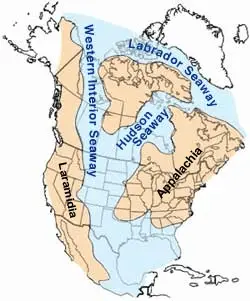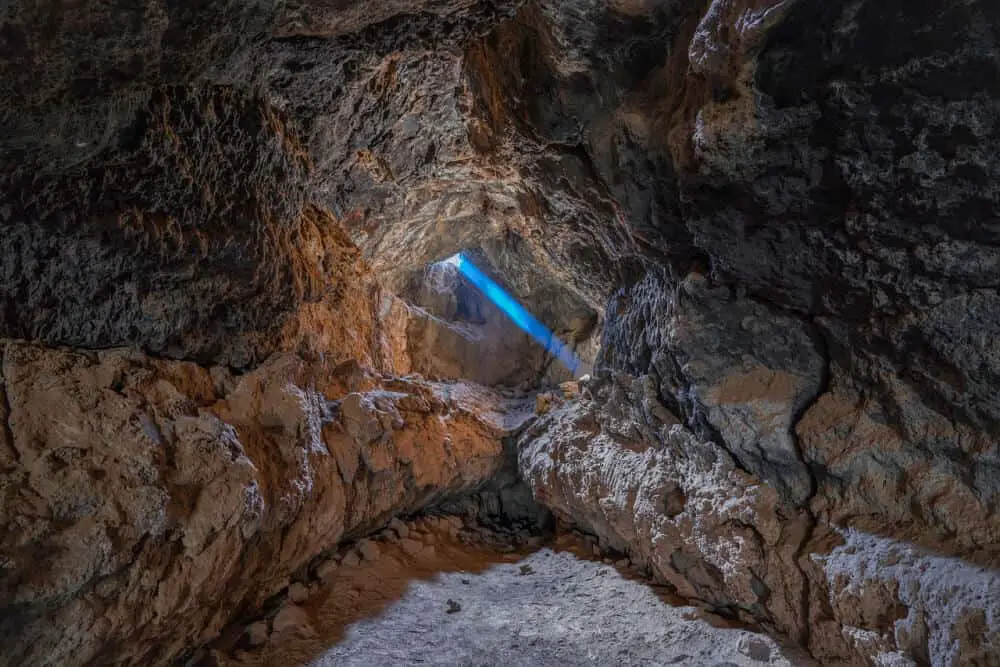Caves are pretty mysterious: not just to you and me, but even to scientists. If you’re new to caving, I really like to share the following facts with you.
We have a pretty good understanding of caves and the way they form. But we don’t know how many caves there actually are. We know for sure that we’ve barely scratched the surface. And that we haven’t discovered the largest yet – it will probably be MUCH bigger than the caves we do know.
Oh, and if you want to explore unexplored territory, caves are probably your best bet. Read on to find out why.
1. We Don’t Really Agree On What a Cave Is
I want to start out with this one, just to get on the same page. It’s true: we don’t really agree on what a cave is. Sure, it’s a hole in the ground. But how big? Do you need to be able to walk around in it? Does it need to have an entrance? You see, it gets complicated quickly.
So why not just call it and come up with a universal definition? Well, what makes sense to call a cave in one place doesn’t make sense to be one in another. It really depends on the environment. Each region deals with different conditions. Each has its own specific type of formation, rock, history. Some regions have very long, narrow passages, others large chambers, others only have potholes. That’s the reason why the requirements to be called a cave differ per state (and country). They all use requirements that make sense in their kind of landscape.
That’s also the reason the numbers greatly vary. Some states have so many caves, they just don’t bother with anything shorter than 30 ft (Tennessee).
But let’s all agree that it’s a hole in the ground. And perhaps it’s also nice if it’s big enough to fit a human inside, that is able to move around a little.
2. Most of the World’s Caves Are Undiscovered
Okay, I touched on this in the previous section. We know of plenty of caves at the moment. And as caving gets more popular, a lot of discoveries are made and mappings are done. But most of the world’s caves are still undiscovered. And I mean by a large margin.
Experts guess that we’ve only discovered about 1% of all the caves on Earth.
That means that the majority of the caves on Earth are undiscovered.
The total number of caves we don’t yet know will probably be about 100x more than the caves we know of.
That’s crazy, right? Do you know the saying: ‘we don’t even know our own oceans?’ It definitely goes for the Earth’s crust as well.
But how come? Well, most caves don’t have an entrance. So most caves are closed off entirely. We can’t enter them and they are difficult to spot from above ground.
There are three types of caves:
- open-entrance caves – obvious and visible entrance – most are probably known
- closed-entrance caves – have an entrance which is closed off by rocks or earth, due to collapse
- entranceless caves – have no entrance whatsoever, a closed system
The last type can only be accessed by creating an entrance, using drills or explosives. And you know, the Earth’s crust is roughly 18 miles (30 kilometers) thick. So there’s a lot of holes to be explored.
So caving will be one of the last frontiers in the coming decades. It’s not just rediscovering caves for fun – there’s actually work to be done by explorers.
Want to know more about how to find caves yourself, and what to look for? I really recommend you to read my post on how to find a cave here.
3. Your Eyes Won’t Adjust to the Dark
Cavers are very meticulous about their headlamps. Why? Well, if it fails, you’re out of luck. Your eyes won’t get used to the dark. No, not after a couple of hours. There is literally no light inside of caves, which means there’s nothing for your eyes to adapt to. Light just doesn’t reach inside caves – making it really one of the darkest places on Earth.
So if you go in, make sure to bring a good headlamp and plenty of spares. It’s best practice to carry 3 individual light sources.
If you want to know what I recommend as a good headlamp, make sure to check out my buyer’s guide. It helps you to pick the right one – also when you’re just starting out or on a budget. You can read the headlamp buyer’s guide here.
4. The TAG Area Used To Be a Sea
The TAG Area contains about 14,000 known caves. That’s a lot. But why do Tennessee, Alabama, and Georgia contain so many caves? Well, the area used to be a shallow sea.
Hundred of millions of years ago, North America was covered by a sea, called the North American Inland Sea. Check it out:

Once the sea level dropped, and the sea retreated, only the limestone remained. So that paved the way for one of the richest caving areas in the U.S., and probably in the world.
If you want to know more about the North American Inland Sea, check out this Wikipedia article.
5. Limestone is Made from Dead Animals
Yup, dead animals.
Most caves are set in limestone because limestone easily dissolves in rainwater. But limestone starts out in water as well. It’s made from sea organisms, like coral, shells, clams, and so on. When they die, their remains sink to the ocean floor, where the calcium carbonate collects. Once the sea retreats, like in our story above, the layer of limestone remains.
This type of rock is called sedimentary – formed by sediments.
6. Most Caves Are Prone to Flooding
Caves can be dangerous, mostly because they’re prone to flooding.
Most caves are formed when limestone slowly dissolves in rainwater over hundreds of thousands of years. The rainwater is slightly acidic, eating away at the rock. After a time, passages form by water running through (this also explains the form of most passages).
So you could say that caves are water highways.
I guess you understand where I’m going with this: caves are the natural path of water, and it only takes some water to flood them.
For most caves, it takes some extended heavy rain, and the water will find it’s way into the cave once more.
Other caves are created by tides: the water swoops in every cycle and retreats with low water. These caves flood like clockwork.
It’s safe to assume that the majority of caves is prone to flooding. Make sure to inform with locals about the cave if you plan to enter it.
By the way, this doesn’t mean that caves flood all the time. A lot of caves almost never flood, but it’s important to know that they CAN and definitely WILL flood every once in a while.
Want to know more about the dangers of caving? Check out my article here: ‘How Dangerous Is Caving Really? – Facts, not opinions’.
7. If You Discover a Cave, You Get to Name It
It’s a tradition that the person that discovers the cave get’s to name it. Not every country or state allows this, but most U.S. states allow you to name it.
Combine that with the fact that most caves are undiscovered: statistically, it’s your best shot at immortality.
But before you enter any wild cave, make sure you know what you’re doing. Wild caves are particularly dangerous. Loose rock, bad air, and so on. Get help if you’re a beginner. Just contact your local grotto and they will probably be glad to help you out – and even take you along for a tour.
Cave exploration can be great fun, and if you learn the basics and get the right gear, it’s reasonably safe and a cool hobby. This blog can be a great start – start by reading my beginner’s guide for example.
If you want to go out cave hunting, perhaps you’ll find my cave finding guide helpful.
8. The 3 Deepest Caves Are Thought To Be Connected
Caves are hydrological systems: so they typically form by water dissolving rock and creating water highways.
This means that most caves are connected. The only question is whether the passages are large enough for a human to fit through.
This is also thought to be the case for the three deepest caves in the world. All three located in Georgia (the country – not the state), all within a couple of miles of each other.
- Veryovkina – 2,212 m or 7,257 ft.
- Krubera – Krubera was the deepest at 2,198 m or 7,208 ft for a period.
- Sarma – The Sarma cave is 1,830 m or 6,004 ft deep.
They are part of the Arabika Massif – a karst-heavy region. The deepest, Veryovkina shaft, leads to a nearly 4 miles (6 km) long system.
Experts think the systems are all connected. This would mean a massive hydrological system, running for dozens of miles.
If you want to know more about the deepest caves in the world, consider reading my article on the 5 deepest caves in the world here.
9. Caves Form in Different Ways
Caves can form in a couple of ways. I’ve already discussed how caves form in limestone. This is called solutional. But it’s also possible for caves to form not from the surface down, but from inside out. Sometimes gas pockets get trapped inside a rock formation, creating a chamber.
Here’s a list with the most common ways for caves to form:
- Solutional – rainwater dissolves limestone
- Corrosional – a flowing stream that contains rock erodes a passage
- Faults – earthquakes offset rock, which creates chambers and passages
- Glacier caves – the ice is trapped and later melts away
- Sea caves – are formed by sea water corrosion
I’ve previously written an article on cave passages and how to recognize them and how they’re formed. I think it’s a great post with a very helpful infographic with all passage shapes. If you like, you can check it out here.
10. Cave Chambers Can Be as Big as Cities
So since caves are waterways, and connected, they can get very large over time. Geologists estimate that there are multiple undiscovered caves that contain halls that are large enough to fit entire cities.
We actually have a great example of this potential. The largest known cave is the Hang Son Doong in Vietnam, at 200 m high, 150 m wide, and 5 km long. Now that’s an impressive space.
11. The Largest Cave Crystals Are 39 Feet – or 12 Meters
Over thousands of years, the most gorgeous speleothems form inside caves. Speleothems, also called cave formations, form slowly out of dripping water, corrosion, chemical reactions and the moist that collects at certain points.
The largest cave crystals are 39 feet (or 12 m) high. They’re huge:

You find them in Cave of the Crystals in Naica, Chihuahua, Mexico. You can’t really visit them, I’m afraid. Not because you aren’t allowed, but because it’s insanely hot and humid there. (90% humidity and 140 degrees Fahrenheit or 60 degrees Celcius.)
12. Humans Used to Live and Pray Inside Caves
Okay, maybe this is a wide-known fact. But humans have used caves as shelter throughout history. Recently cave divers have discovered some magnificent underwater cave systems in Yucatan that were used by the Aztecs as temples.
Caves are just great hideouts, and a lot of animals (occasionally) retreat inside a cave. But it seems that humans tend to view caves as magical or spiritual, even today. For early humans, caves played a part in religious rituals. The many cave temples across the world at least indicate it.
13. You Could Also Live Inside a Cave
If you like caves, you can actually live inside one. It’s not common across the world, but most cave-rich areas have some sort of cave-dwelling. There are a lot of beautiful cave houses for sale in Andalusia, Spain (South), for example. France also has plenty of cave houses for sale.
It actually makes sense. The chambers are there already. Caves are an amazing shelter place. You don’t need climate control – the temperature is extremely stable. There are two cons, however: you can’t quickly hang a picture frame, and you probably don’t have a lot of windows.
But if you can live with that, it’s a great alternative living space.
14. Caves Are Less Dangerous Than You Think
To be fair, it’s not that simple. Caves can be very dangerous, because of flooding, death by fall, ‘bad air’, and so on. But statistically, caves aren’t super dangerous. Your odds of dying are roughly 1 in 3,332. But only if you’re a ‘high-risk caver’. That means you’re a real semi-professional caver that explores dangerous and wild caves with the proper gear and so on (ie. most of us).
You’re about 3 times more likely to die from caving than from kayaking – but you’re more likely to die in a boxing match than inside a cave.
I did some serious research into the matter and have written a good article about the risks of caving. I really recommend you read it – it gives a good picture of how dangerous it actually is. I’m actually really proud of this article. Click here to read more about the dangers of caving.
15. You Won’t Get Lost Forever
It’s the biggest fear for most people. Some people never enter a cave because they are afraid to never return. To get lost forever after entering a cave. Forever.
A lot of people DO actually get lost. But almost no one actually dies due to getting lost. Most cavers that lose their way once they’re inside are rescued within a day or two.
As I heard a caver say once: just enjoy the thrill of the experience. Statistically, the chance of dying there is next to none. But it will probably get uncomfortable, cold, and frightening.
Okay, you want to make sure that people will come looking for you. Always let someone who cares know you’ll be inside a cave. Also, leave the location of the entrance. Also, let them know at what time they should expect you to return. This way, someone will call the emergency services if you get stuck.
Remember that it will take most people up to 3 hours to realize you’re actually lost and call the police. Then, they have to come looking for you. So expect it to take up to 6 hours AFTER you would return before you get rescued.
If you’re lost right now, find yourself with an internet connection, and want to get out: I’ve got your back. Be sure to read my short guide on How to Escape a Cave.
Related Questions
How long does limestone take to form? A millimeter of limestone sediment takes 1,000 – 2,000 years to form. Karst regions form over millions of years. Limestone is a sedimentary rock, made from shells, clams, and coral that sink to the ocean floor after dying. The cycle includes an entire era, in which enough organisms die and are collected. Then, the sea must retreat and the limestone must dry out.

